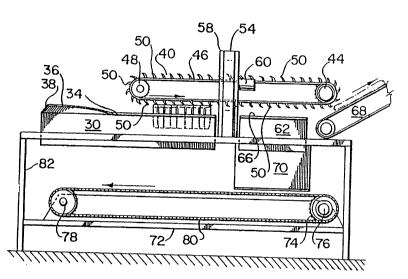Some of the information on this Web page has been provided by external sources. The Government of Canada is not responsible for the accuracy, reliability or currency of the information supplied by external sources. Users wishing to rely upon this information should consult directly with the source of the information. Content provided by external sources is not subject to official languages, privacy and accessibility requirements.
Any discrepancies in the text and image of the Claims and Abstract are due to differing posting times. Text of the Claims and Abstract are posted:
| (12) Patent: | (11) CA 2010034 |
|---|---|
| (54) English Title: | APPARATUS AND METHOD FOR CUTTING MEAT |
| (54) French Title: | APPAREIL ET METHODE DE COUPE DES VIANDES |
| Status: | Expired |
| (52) Canadian Patent Classification (CPC): |
|
|---|---|
| (51) International Patent Classification (IPC): |
|
| (72) Inventors : |
|
| (73) Owners : |
|
| (71) Applicants : | |
| (74) Agent: | MILTONS IP/P.I. |
| (74) Associate agent: | |
| (45) Issued: | 1993-01-05 |
| (22) Filed Date: | 1990-02-14 |
| (41) Open to Public Inspection: | 1991-08-14 |
| Examination requested: | 1990-02-14 |
| Availability of licence: | N/A |
| (25) Language of filing: | English |
| Patent Cooperation Treaty (PCT): | No |
|---|
| (30) Application Priority Data: | None |
|---|
Abstract
The present invention relates to an apparatus and method of
cutting meat. The apparatus and method is particularly
directed to separating a backbone portion from a rib portion
of a piece of meat. The apparatus is comprised of a vertical
orientation unit for vertically orienting the piece of meat.
The orientation unit includes a longitudinal receiving channel
having a generally horizontal top surface, the surface having
a slot. The width of the slot accommodates the rib portion
but not the backbone portion so that the backbone portion is
held above the orientation unit. A moving unit is provided
and is adapted to contact the backbone portion for moving the
piece of meat horizontally in the direction of the
longitudinal axis of the channel. A cutting unit is provided
which includes a saw blade, a portion of which is oriented
horizontally, wherein the cutting unit horizontally cuts the
rib portion from the backbone portion.
Note: Claims are shown in the official language in which they were submitted.
Note: Descriptions are shown in the official language in which they were submitted.

For a clearer understanding of the status of the application/patent presented on this page, the site Disclaimer , as well as the definitions for Patent , Administrative Status , Maintenance Fee and Payment History should be consulted.
| Title | Date |
|---|---|
| Forecasted Issue Date | 1993-01-05 |
| (22) Filed | 1990-02-14 |
| Examination Requested | 1990-02-14 |
| (41) Open to Public Inspection | 1991-08-14 |
| (45) Issued | 1993-01-05 |
| Expired | 2010-02-14 |
There is no abandonment history.
Note: Records showing the ownership history in alphabetical order.
| Current Owners on Record |
|---|
| OLYMEL S.E.C./OLYMEL L.P. |
| Past Owners on Record |
|---|
| COOPERATIVE FEDEREE DE QUEBEC |
| OLYMEL, SOCIETE EN COMMANDITE |
| PERREAULT, MARTIN |